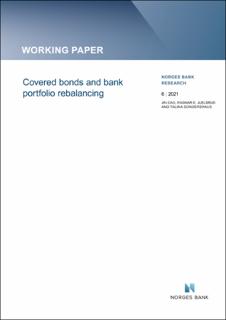| dc.contributor.author | Cao, Jin | |
| dc.contributor.author | Juelsrud, Ragnar E. | |
| dc.contributor.author | Sondershaus, Talina | |
| dc.date.accessioned | 2021-09-28T06:02:10Z | |
| dc.date.available | 2021-09-28T06:02:10Z | |
| dc.date.issued | 2021 | |
| dc.identifier.isbn | 978-82-8379-201-0 | |
| dc.identifier.issn | 1502-8190 | |
| dc.identifier.uri | https://hdl.handle.net/11250/2783866 | |
| dc.description.abstract | We use administrative and supervisory data at the bank and loan level to investigate the impact of the introduction of covered bonds on the composition of bank balance sheets and bank risk. Covered bonds, despite being collateralized by mortgages, lead to a shift in bank lending from mortgages to corporate loans. Young and low-rated firms in particular receive more credit, suggesting that overall credit risk increases. At the same time, we find that total balance sheet liquidity increases. We identify the channel in a theoretical model and provide empirical evidence: Banks with low initial liquidity and banks with sufficiently high risk-adjusted return on firm lending drive the results. | en_US |
| dc.language.iso | eng | en_US |
| dc.publisher | Norges Bank | en_US |
| dc.relation.ispartofseries | Working Paper;6/2021 | |
| dc.rights | Attribution-NonCommercial-NoDerivatives 4.0 Internasjonal | * |
| dc.rights.uri | http://creativecommons.org/licenses/by-nc-nd/4.0/deed.no | * |
| dc.subject | asset encumbrance | en_US |
| dc.subject | covered bond | en_US |
| dc.subject | portfolio rebalancing | en_US |
| dc.subject | liquidity management | en_US |
| dc.subject | JEL: G21 | en_US |
| dc.subject | JEL: G23 | en_US |
| dc.subject | JEL: G28 | en_US |
| dc.title | Covered bonds and bank portfolio rebalancing | en_US |
| dc.type | Working paper | en_US |
| dc.description.version | publishedVersion | en_US |
| dc.subject.nsi | VDP::Samfunnsvitenskap: 200::Økonomi: 210::Samfunnsøkonomi: 212 | en_US |
| dc.source.pagenumber | 49 | en_US |

